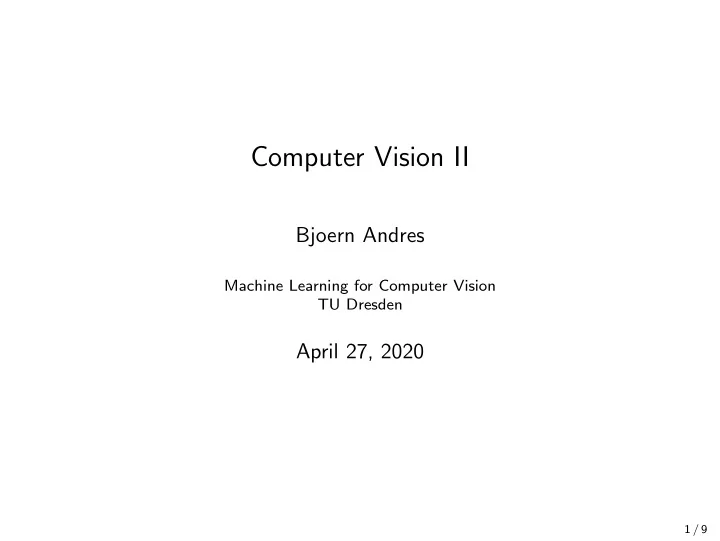

Computer Vision II Bjoern Andres Machine Learning for Computer Vision TU Dresden April 27, 2020 1 / 9
Pixel classification We consider: ◮ n 0 , n 1 ∈ N called the height and width of a digital image, V = [ n 0 ] × [ n 1 ] called the set of pixels, and the grid graph G = ( V , E ) ◮ A non-empty set R whose elements are called colors ◮ A function x : V → R called a digital image The task of pixel classification is concerned with making decisions at the pixels, e.g., decisions y : V → { 0 , 1 } indicating whether a pixel v ∈ V is of interest ( y v = 1) or not of interest ( y v = 0). 2 / 9
Pixel classification Source: https://www.pexels.com/photo/nature-flowers-garden-plant-67857/ For instance, we may wish to map to 1 precisely those pixels of the above image that depict the yellow part of any of the flowers. 3 / 9
Pixel classification We begin with a trivial mathematical abstraction of the task of pixel classification: Definition. For any c : V → R , the instance of the trivial pixel classification problem w.r.t. c has the form � min c v y v (1) y ∈{ 0 , 1 } V v ∈ V In practice, we would seek to construct the function c w.r.t. the image in such a way that ◮ c v < 0 if we consider y v = 1 the right decision ◮ c v > 0 if we consider y v = 0 the right decision 4 / 9
Pixel classification Assuming the decision for a pixel v ∈ V depends on the color x v ∈ R of that pixel only, we can ◮ construct a function ξ : R → R ◮ define c v = ξ ( x v ) for any v ∈ V . In some practical applications, e.g. photo editing, a suitable function ξ can be constructed manually, typically with the help of carefully designed GUIs. 5 / 9
Pixel classification Assuming the decision for a pixel v ∈ V depends on the location v and on the colors of all pixels in a neighborhood V d ( v ) ⊆ V around v , e.g. V d ( v ) = { w ∈ V | � v − w � max ≤ d } , we can ◮ construct, for any pixel v , a function ξ v : R V d ( v ) → R that assigns a real number ξ v ( x ′ ) to any coloring x ′ : V d ( v ) → R of the d -neighborhood of v ◮ define c v = ξ ( x V d ( v ) ) for any v ∈ V . The task of constructing such functions ξ v is typically addressed by means of machine learning , e.g., logistic regression or a CNN. 6 / 9
Pixel classification In practice, solutions to the trivial pixel classification problem can be improved by exploiting prior knowledge about feasible combinations of decisions. Firstly, we consider prior knowledge saying that decisions at neighboring pixels v , w ∈ V are more likely to be equal ( y v = v w ) than unequal ( y v � = y w ). Definition. For any c : V → R and any c ′ : E → R + 0 , the instance of the smooth pixel classification problem w.r.t. c and c ′ has the form � � c ′ { v , w } | y v − y w | min c v y v + (2) y ∈{ 0 , 1 } V v ∈ V { v , w }∈ E � �� � ϕ ( y ) 7 / 9
Pixel classification A na¨ ıve algorithm for this problem is local search with a transformation T v : { 0 , 1 } V → { 0 , 1 } V that changes the decision for a single pixel, i.e., for any y : V → { 0 , 1 } and any v , w ∈ V : � 1 − y w if w = v T v ( y )( w ) = otherwise . y w Initially, y : V → { 0 , 1 } and W = V while W � = ∅ W ′ := ∅ for each v ∈ W if ϕ ( T v ( y )) − ϕ ( y ) < 0 y := T v ( y ) W ′ := W ′ ∪ { w ∈ V | { v , w } ∈ E } W := W ′ 8 / 9
Pixel classification Suggested self-study: ◮ Construct a function ξ (Slide 5) for the task and image shown on Slide 3; visualize the output of ξ . ◮ Implement the local search algorithm (Slide 8) for the smooth pixel classification problem (2) such that ϕ ( T v ( y )) − ϕ ( y ) is computed in constant time. ◮ Apply your implementation to c v = ξ ( x v ) and various positive constants c ′ . ◮ Discuss your results and compare these to the solutions of the trivial pixel classification problem (1) that is solved by your implementation for c ′ = 0. Advanced self-study: ◮ Generalize your implementation to operate on classifications y : V → { 0 , 1 , 2 } . ◮ Use your implementation to separate also the white leaves of the flowers in the image shown on Slide 3. 9 / 9
Recommend
More recommend